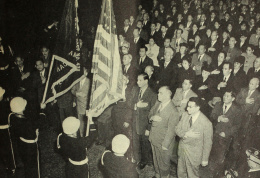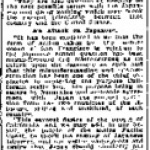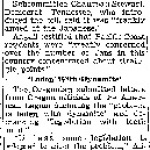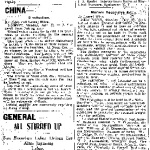Immigration Act of 1952
A Cold War measure, the 1952 Immigration Act formally ended Asian exclusion as a feature of U.S. immigration policy, even as it strengthened the powers of the federal government to detain and prosecute suspected subversives. The Act allotted nominal immigration quotas to Japan and the rest of Asia, but the racial basis of these quotas limited their actual impact. It also eliminated race as a basis for naturalization, making Japanese and other foreign-born Asians eligible to become American citizens for the first time. Highly controversial, the McCarran-Walter Act had to overcome widespread opposition and a presidential veto before taking effect in June 1952.
Background to the 1952 Act
Between 1882 and 1924, the U.S. Congress passed a series of laws that together banned Asians from immigrating to the U.S. on the basis of race. The first of these, the Chinese Exclusion Act of 1882 barred Chinese laborers from entering the U.S. Reflecting the nativist political climate of the World War I years, the 1917 and 1924 Immigration Acts created the Asiatic Barred Zone and upheld Asians' exclusion from entering the U.S. on the basis of their status as "aliens ineligible to citizenship." By World War II, the Asian exclusion regime was fully in place. As a U.S. protectorate, the Philippines was exempted from the 1924 exclusions. Filipino migration remained open through 1934, when the Tydings-McDuffie Act restricted the number to fifty persons annually.
The 1940s brought the initial dismantling of the Asian exclusion regime through piecemeal acts granting immigration quotas and naturalization rights to Chinese, South Asians (Indians), and Filipinos, all of whom fought alongside the U.S. in World War II. A product of the wartime Sino-American alliance, the Magnuson Act (1943) repealed the Chinese Exclusion Acts, made Chinese eligible for U.S. citizenship, and gave China an annual immigration quota of 105. Part of Washington's official response to impending decolonization across Asia, the Luce-Celler Act (1946) ended exclusion and extended immigration and naturalization rights to South Asians and Filipinos in anticipation of their imminent independence from colonial rule: India from Great Britain and the Philippines from the U.S. (in 1947 and 1946, respectively.)
By the late 1940s, it was widely agreed that the U.S. immigration system required an overhaul. Meaningful postwar legislative reform was delayed, however, by a "conservative coalition" of restrictionist Southern Democrats and conservative Republicans who used their influence in Congress to block immigration bills that did not reflect their interests. [1]
Overview of the 1952 Act
The 1952 Act was a product of the Cold War, shaped by Washington's overriding obsession with containing Communism at home and in overseas sites like Asia. The legislation's co-sponsors—House Republican Francis Walter (R-PA) and Senate Democrat Pat McCarran (D-NV)—were well-known anti-Communists and restrictionists. Both of these tendencies were reflected in the Act's provisions, which gave the appearance of liberalization while actually circumscribing the civil rights and liberties of foreign-born Americans, particularly those suspected of holding subversive beliefs.
In the area of immigration, the Act retained the controversial national origins quota system, while introducing a system of preferences based on skill and family reunification that served as the basis for the 1965 Immigration Act. While the Asia-Pacific Triangle did extend nominal immigration quotas (in most cases, 100 per year) to all of Asia, the racial basis of the Asian immigration quotas ensured that the number of immigrants entering the U.S. from Asia would never increase significantly. The race-based nature of the Asian quotas was different from the nationality-based quotas assigned to European groups. Under this system, a person of Chinese ancestry entering the U.S. from Latin America would still count toward the Chinese quota regardless of nationality and place of birth.
Building upon the national security provisions of the 1950 McCarran Law, the 1952 Act expanded the power of the federal government to exclude, deport, and detain aliens deemed subversive or seen as holding subversive views. Even as the Act struck down race as a basis for citizenship eligibility, it strengthened the requirements for citizenship in other ways and made it easier for the government to denaturalize persons on the grounds of national security.
While broad-based in scope, the Act disproportionately benefited Japan, which received the largest annual immigration quota of 185 per year (compared to 100 for other Asian powers). At the time of its passage, more than 90% of the aliens made eligible for U.S. citizenship were Issei , or first-generation immigrants of Japanese descent. Committed to securing naturalization for aging Issei, the Japanese American Citizens League (JACL) played an active role in lobbying for the bill's passage, a decision for which it came under heavy criticism by other civil liberties and ethnic/racial organizations, including the NAACP, the Chinese American Citizens Alliance (CACA), and the second-generation Japanese American group, the Nisei Progressives . Presumptive racial ties linking Japanese Americans to Japan amplified the voice of Nisei lobbyists active in Washington, DC, including JACL Washington representative Mike Masaoka , who was seen by many U.S. officials as uniquely qualified to speak about the Act's significance for U.S.-Japan relations.
Contested Passage & International Context of the 1952 Act
Passage of the 1952 Immigration Act was hotly contested, and even today, the Act is widely recognized as one of the most controversial pieces of legislation in American history.
The inclusion of the widely popular Asian immigration and naturalization provisions proved key to the legislation's successful passage through Congress. Their incorporation into the omnibus McCarran-Walter bill was strategic, part of a deliberate move by its anti-Communist sponsors to divide Congressional opposition and thereby ensure its victory. The tactic worked, and the legislation passed both Houses of Congress in mid-1952. It was soon vetoed by the Truman White House, but Congress overrode the veto to make it law in late 1952.
Calls for Asian immigration reform benefited from several developments of the postwar years. The first was a surge in official and media sympathy for Japanese Americans caused by growing remorse over the injustice of wartime incarceration. Some of the same lawmakers who during the war had vilified Japanese Americans as a menace to American society now lamented the wartime incarceration as a "shameful" mistake, even as private opinions remained more mixed. [2] Their cause was further served by the JACL's ambitious public relations campaign, which aimed to increase Americans' awareness of Nisei military service and sacrifice "from behind barbed wire" during World War II. [3]
Seeking to tap into the anti-Communist fervor of the times, advocates framed the exclusion repeal provisions as necessary to U.S. Cold War interests in Asia. Their attempts to link the measure to U.S. containment goals in Asia gained greater resonance after the 1949 Communist victory in China transformed Japan into America's main anti-Communist bulwark in the region and the base of Allied military operations for the Korean conflict.
Legacy of the 1952 Law
As with the piecemeal repeal measures enacted during the 1940s, the changes wrought by the Act's immigration provisions were more symbolic than real. The nominal quotas did little to increase the number of Asians entering the U.S. in practice. Between 1952 and 1965, roughly 90% of Asian immigrants came to America outside of the quotas. The Act's naturalization provisions had wider impact. By striking down race as a basis for citizenship eligibility, the 1952 Act notably embedded the principle of color-blind citizenship as a feature of U.S. naturalization law. Between 1952 and 1965, more than 40,000 first-generation Japanese became U.S. citizens, many after decades of waiting.
Enacted in 1952, the Immigration Act gave rise to an even greater backlash after passage than before. The liberal critique was spelled out in Whom Shall We Welcome (1953), a report issued by the President's Commission on Immigration and Naturalization, which Truman created after Congress overrode his veto. The system put in place by the 1952 Act was eventually overhauled by the Immigration, or Hart-Celler, Act of 1965, which featured a preference system based on family reunification and skills.
For More Information
Divine, Robert A. American Immigration Policy, 1924-1952 . New Haven: Yale University Press, 1957.
Gotanda, Neil. "Towards Repeal of Asian Exclusion." In Asian Americans and Congress: A Documentary History , edited by Hyung-chan Kim, 309-336. Westport, CT: Greenwood Press, 1996.
Hosokawa, Bill. JACL: In Quest of Justice . New York: William Morrow & Company, 1982.
Tamayo, William R. "Asian Americans and the McCarran-Walter Act." In Asian Americans and Congress: A Documentary History , edited by Hyung-chan Kim, 337-528. Westport, CT: Greenwood Press, 1996.
U.S. President's Commission on Immigration and Naturalization. Whom Shall We Welcome . Washington, D.C.: U.S. Government Printing Office, 1953.
Footnotes
- ↑ Daniel Tichenor, Dividing Lines: The Politics of Immigration Control (Princeton: Princeton University Press, 2002), 177.
- ↑ See Naoko Shibusawa, America's Geisha Ally: Reimagining the Japanese Enemy (Cambridge: Harvard University Press, 2006).
- ↑ Go for Broke actor Van Johnson, quoted in Shibusawa, America's Geisha Ally , 269.
Last updated May 14, 2024, 3:40 p.m..

 Media
Media








